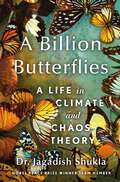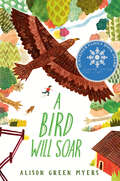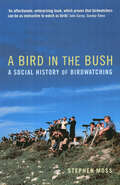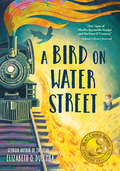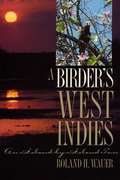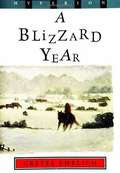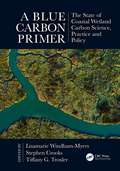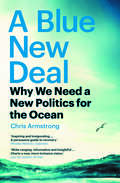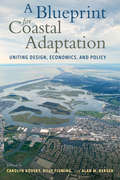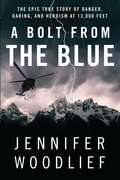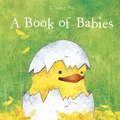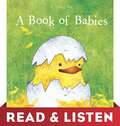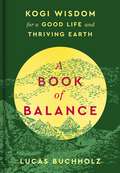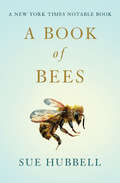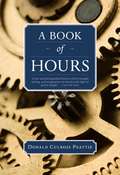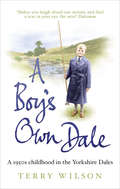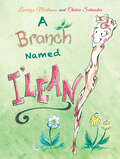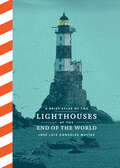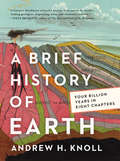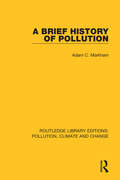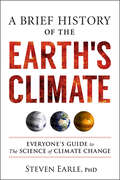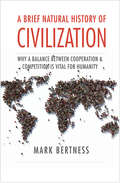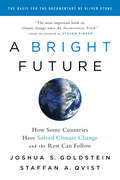- Table View
- List View
A Billion Butterflies: A Life in Climate and Chaos Theory
by Dr. Jagadish ShuklaThe amazing true story of the man behind modern weather predictionConsider a world without weather prediction. How would we know when to evacuate communities ahead of fires or floods, or figure out what to wear tomorrow? Until 40 years ago, we couldn’t forecast weather conditions beyond ten days. Renowned climate scientist Dr. Jagadish Shukla is largely to thank for modern weather forecasting. Born in rural India with no electricity, plumbing, or formal schools, he attended classes that were held in a cow shed. Shukla grew up amid turmoil: overwhelming monsoons, devastating droughts, and unpredictable crop yields. His drive brought him to the Indian Institute of Tropical Meteorology, despite little experience. He then followed an unlikely path to MIT and Princeton, and the highest echelons of climate science. His work, which has enabled us to predict weather farther into the future than previously thought possible, allows us to feed more people, save lives, and hold on to hope in a warming world.Paired with his philanthropic endeavors and extreme dedication to the field, Dr. Shukla has been lauded internationally for his achievements, including a shared Nobel Peace Prize with Al Gore for his governmental research on climate change. A Billion Butterflies is a wondrous insider’s account of climate science and an unbelievable memoir of his life. Understanding dynamical seasonal prediction will change the way you experience a thunderstorm or interpret a forecast; understanding its origins and the remarkable story of the man who discovered it will change the way you see our world.
A Bird Will Soar
by Alison Green MyersA heartfelt and hopeful debut about a bird-loving autistic child whose family's special nest is in danger of falling apart. <p><p> Axel loves everything about birds, especially eagles. No one worries that an eagle will fly too far and not come home—a fact Axel wishes his mother understood. Deep down, Axel knows that his mother is like an osprey—the best of all bird mothers—but it’s hard to remember that when she worries and keeps secrets about important things. His dad is more like a wild turkey, coming and going as he pleases. His dad’s latest disappearance is the biggest mystery of all. Despite all this, Axel loves his life—especially the time he spends with his friends observing the eagles’ nest in the woods near his home. <p><p> But when a tornado damages not only Axel’s home but the eagles’ nest, Axel's life is thrown into chaos. Suddenly his dad is back to help repair the damage, and Axel has to manage his dad’s presence and his beloved birds’ absence. Plus, his mom seems to be keeping even more secrets. But Axel knows another important fact: an eagle’s instincts let it soar. Axel must trust his own instincts to help heal his family and the nest he loves.
A Bird in the Bush: A Social History of Birdwatching
by Stephen MossThis journey through the world of birdwatchers is “a wonderful book. . . . fascinating, often hilarious anecdotes and information” (Daily Mail, Critic’s Choice).Scholarly, authoritative, and above all supremely readable, Stephen Moss’s book is the first to trace the fascinating history of how and why people have watched birds for pleasure, from the beginnings with Gilbert White in the eighteenth century through World War II POWs watching birds from inside their prison camp and all the way to today’s “twitchers” with their bleeping pagers, driving hundreds of miles for a rare bird.“Proves that birdwatchers can be as instructive to watch as birds.” —Sunday Times“Thoroughly researched and well-written.” —The Guardian“Moss knows his subject intimately and writes about it with just the right mixture of affection and occasional quizzicality.” —Sunday Telegraph“It would be difficult to imagine anyone producing a more comprehensive, thoughtful, intelligent and entertaining examination of how people have watched birds at each point in history. In fact, it is one of the few books which might prove such compulsive reading that even a dedicated twitcher might forgo a day in the field to stay at home to finish it.” —Birding World
A Bird on Water Street
by Elizabeth O. Dulemba"Elizabeth Dulemba seamlessly melds a coming-of-age story to the reality of life in a single-industry town. This is a book that sings." — Betsy Bird, School Library Journal blog A Fuse #8 ProductionLiving in Coppertown is like living on the moon. Everything is bare—there are no trees, no birds, no signs of nature at all. And while Jack loves his town, he hates the dangerous mines that have ruined the land with years of pollution. When the miners go on strike and the mines are forced to close, Jack's life-long wish comes true: the land has the chance to heal.But not everyone in town is happy about the change. Without the mines, Jack's dad is out of work and the family might have to leave Coppertown. Just when new life begins to creep back into town, Jack might lose his friends, his home, and everything he's ever known.Dulemba paints a vivid picture of life in the Appalachia in this beautiful story about a boy looking for new beginnings while struggling to hold on to the things he loves most.
A Birder's West Indies: An Island-by-Island Tour
by Roland H. WauerThe West Indies offer so much more than sun, sand, and shopping. This sweeping arc of islands, which runs from Cuba to Grenada and includes the Virgin Islands, teems with a rich diversity of plant and animal life. Up to 40 percent of the plants in some forests are found nowhere else on earth, while the West Indian flyway is a critical link in the migratory routes of many birds. In A Birder's West Indies, Roland Wauer takes you on an island-by-island journey of discovery. He describes the unique natural features of each island and recounts his often fascinating experiences in seeking out the nearly 400 species of birds known in the West Indies. His accounts give insight into the birds' habitats, status, and ecology and record some of the threats posed by human activities. For readers planning trips to the West Indies, Wauer also includes helpful, up-to-date facts about the best times to travel, the kinds of entry and customs systems to expect, the money exchange services available, and general information about weather, food, and accommodations. Filling a unique niche among current guides, A Birder's West Indies offers both professional ornithologists and avocational bird watchers a chance to compare notes and experiences with an expert observer. And for readers who haven't yet visited the islands, Wauer's fluid prose and lovely color photographs will be the next-best thing to being there-and an irresistible invitation to go.
A Blizzard Year: Timmy's Almanac of the Seasons
by Gretel EhrlichEhrlich ventures confidently into new terrain in her eloquent and affecting debut children's novel. Her prose, as pristine and spare as her snow-covered landscape, portrays the quiet drama of the changing seasons -- in both their consistency and unpredictability -- as well as a family attuned to nature's every nuance.
A Blue Carbon Primer: The State of Coastal Wetland Carbon Science, Practice and Policy (CRC Marine Science)
by Lisamarie Windham-Myers Stephen Crooks Tiffany G. TroxlerKey features: Captures the historic context and recent developments in science and policy arenas that address the potential for coastal wetlands to be considered as significant contributors to carbon sequestration Links multiple levels of science (biogeochemistry, geomorphology, paleoclimate, etc.) with blue carbon concepts (science, policy, mapping, operationalization, economics) in a single compendium Concludes with a discussion of future directions which covers integrated scientific approaches, impending threats and specific gaps in current knowledge Includes 7 case studies from across the globe that demonstrate the benefits and challenges of blue carbon accounting Written by over 100 leading global blue carbon experts in science and policy. Blue Carbon has emerged as a term that represents the distinctive carbon stocks and fluxes into or out of coastal wetlands such as marshes, mangroves, and seagrasses. The Blue Carbon concept has rapidly developed in science literature and is highly relevant politically, as nations and markets are developing blue carbon monitoring and management tools and policies. This book is a comprehensive and current compendium of the state of the science, the state of maps and mapping protocols, and the state of policy incentives (including economic valuation of blue carbon), with additional sections on operationalizing blue carbon projects and 7 case studies with global relevance.
A Blue New Deal: Why We Need a New Politics for the Ocean
by Chris ArmstrongAn urgent account of the state of our oceans today—and what we must do to protect them The ocean sustains life on our planet, from absorbing carbon to regulating temperatures, and, as we exhaust the resources to be found on land, it is becoming central to the global market. But today we are facing two urgent challenges at sea: massive environmental destruction, and spiraling inequality in the ocean economy. Chris Armstrong reveals how existing governing institutions are failing to respond to the most pressing problems of our time, arguing that we must do better. Armstrong examines these crises—from the fate of people whose lands will be submerged by sea level rise, to the exploitation of people working in fishing, to the rights of marine animals—and makes the case for a powerful World Ocean Authority capable of tackling them. A Blue New Deal presents a radical manifesto for putting equality, democracy, and sustainability at the heart of ocean politics.
A Blueprint for Coastal Adaptation: Uniting Design, Economics, and Policy
by Carolyn KouskyTens of millions of Americans are at risk from sea level rise, increased tidal flooding, and intensifying storms. The design and policy decisions that have shaped coastal areas are in desperate need of updates to help communities better adapt to a changing climate. A Blueprint for Coastal Adaptation identifies a bold new research and policy agenda and provides implementable options for coastal communities. In this book, coastal adaptation experts discuss the interrelated challenges facing communities experiencing sea level rise and increasing storm impacts. These issues extend far beyond land use planning into housing policy, financing for public infrastructure, insurance, fostering healthier coastal ecosystems, and more. Deftly addressing far-reaching problems from cleaning up contaminated, abandoned sites, to changes in drinking water composition, chapters give a clear-eyed view of how we might yet chart a course for thriving coastal communities. They offer a range of climate adaptation policies that could protect coastal communities against increasing risk, while preserving the economic value of these locations, their natural environments, and their community and cultural values. Lessons are drawn from coastal communities around the United States to present equitable solutions. The book provides tools for evaluating necessary tradeoffs to think more comprehensively about the future of our coastal communities. Coastal adaptation will not be easy, but planning for it is critical to the survival of many communities. A Blueprint for Coastal Adaptation will inspire innovative and cross-disciplinary thinking about coastal policy at the state and local level while providing actionable, realistic policy and planning options for adaptation professionals and policymakers.
A Bolt from the Blue: The Epic True Story of Danger, Daring, and Heroism at 13,000 Feet
by Jennifer WoodliefFIVE INJURED CLIMBERS. TEN SEASONED RANGERS. ONE IMPOSSIBLE RESCUE. On the afternoon of July 26, 2003, six vacationing mountain climbers ascended the peak of the Grand Teton in Jackson Hole, Wyoming. Rain and colliding air currents blew in, and soon a massive electrical charge began to build. As the group began to retreat from its location, a colossal lightning bolt struck and pounded through the body of every climber. One of the six died instantly, one lay critically injured next to her body, and four dangled perilously into the chasm below. In riveting, page-turning prose, veteran journalist Jennifer Woodlief tells the story of the climb, the arrival of the storm, and the unprecedented rescue by the Jenny Lake Rangers, one of the most experienced climbing search-and-rescue teams in the country. Against the dramatic landscape of the Teton Range, Woodlief brings to life the grueling task of the rangers, a band of colorful characters who tackle one of the riskiest, most physically demanding jobs in the world. By turns terrifying and exhilarating, A Bolt from the Blue is both a testament to human courage and an astonishing journey into one of history’s most dangerous mountain rescues.
A Book of Babies
by Il Sung NaWhen the flowers begin to bloom and the world starts turning green, animals everywhere are born. Some have lots of brothers and sisters. Some have none at all. Some are born with soft, warm fur, while some are born with smooth scales. Some can walk right away--others need a little help! As with Il Sung Na's previous offerings, A Book of Babies is filled with rich illustrations, endearing animals, and a spare text--all wrapped up in a gorgeous package.
A Book of Babies: Read & Listen Edition
by Il Sung NaWhen the flowers begin to bloom and the world starts turning green, animals everywhere are born. Some have lots of brothers and sisters. Some have none at all. Some are born with soft, warm fur, while some are born with smooth scales. Some can walk right away—others need a little help! As with Il Sung Na's previous offerings, A Book of Babies is filled with rich illustrations, endearing animals, and a spare text—all wrapped up in a gorgeous package.This Read & Listen Edition contains audio narration.
A Book of Balance: Kogi Wisdom for a Good Life and Thriving Earth
by Lucas BuchholzWe all need help centering ourselves to serve ourselves and our world. In this small, beautiful book, the Kogi—a remote and ancient tribe in the mountains of Colombia--offer their learnings. They pose nine thought-provoking questions to help us live harmoniously with the earth and in turn find happiness and purpose in every moment.“Just as we are both sitting here and talking, this is how we can live well. All of this you will write in the book.”—Mama Jose Gabriel, a spiritual guide of the Kogi tribe, to author Lucas BuchholzFor centuries, the Kogi have lived in seclusion in Colombia’s remote Sierra Nevadas, known as “the heart of the world.” But in recent years, concerned by the environmental degradation they have experienced in their villages and forests, a few emissaries from the tribe emerged to bring an urgent and loving message to the West—advice on how to live in harmony with the earth.Buchholz was invited to their home to receive and transcribe this message. A Book of Balance takes us on a journey into a startlingly beautiful landscape and into a sacred space: the traditional fireside circle held regularly by the tribe. In this circle, members consider key questions essential to their community.In this slim volume of spiritual introspection, they ask us to share in their practice, posing nine questions that focus our minds and hearts on who we are, who we can become.Throughout we hear the words of the Kogi elders, wisdom that offers revelations, inspiration, and direction for our everyday lives.A beautiful book to own, to share with friends, and discuss in community.
A Book of Bees: And How To Keep Them
by Sam Potthoff Sue HubbellA New York Times Notable Book: "A melodious mix of memoir, nature journal, and beekeeping manual" (Kirkus Reviews). Weaving a vivid portrait of her own life and her bees' lives, author Sue Hubbell lovingly describes the ins and outs of beekeeping on her small Missouri farm, where the end of one honey season is the start of the next. With three hundred hives, Hubbell stays busy year-round tending to the bees and harvesting their honey, a process that is as personally demanding as it is rewarding. Exploring the progression of both the author and the hive through the seasons, this is "a book about bees to be sure, but it is also about other things: the important difference between loneliness and solitude; the seasonal rhythms inherent in rural living; the achievement of independence; the accommodating of oneself to nature" (ThePhiladelphia Inquirer). Beautifully written and full of exquisitely rendered details, it is a tribute to Hubbell's wild hilltop in the Ozarks and of the joys of living a complex life in a simple place.
A Book of Hours
by Donald Culross PeattieA Book of Hours contains 24 essays, one for each hour of the day, that seek to bridge the gap between definitive scientific philosophy and the sheer unadulterated beauty that Donald Culross Peattie envisioned within everyday life. The Boston Transcript referred to this collection as "science, in sheer poetry," and the Chicago Daily Tribune mused that "it leaves one a better man for having read it" and offers "the inevitableness of natural laws and the truth of beauty, if one cares to seek it."
A Book of Hours
by Donald Culross PeattieA Book of Hours contains 24 essays, one for each hour of the day, that seek to bridge the gap between definitive scientific philosophy and the sheer unadulterated beauty that Donald Culross Peattie envisioned within everyday life. The Boston Transcript referred to this collection as "science, in sheer poetry," and the Chicago Daily Tribune mused that "it leaves one a better man for having read it" and offers "the inevitableness of natural laws and the truth of beauty, if one cares to seek it."
A Boy's Own Dale: A 1950s childhood in the Yorkshire Dales
by Terry WilsonGrowing up in rural Yorkshire in the 1940s and 50s, Terry Wilson spent his school days hunting down Just William books, cutting up apples to help with fractions and staring out the window dreaming up new schemes. But it was on the Dales themselves that Terry came into his own. Whether he was 'out-fishing' the adults with his homemade rod, grouse-beating for the lady of the manor, helping to bring in the farmers' hay in exchange for rabbit shooting rights, or growing his own prize caulis, his idiosyncratic and inventive mind is only matched by his love of nature. Told with affection, dry humour and a respect for the landscape and its people, through Terry's eyes we meet farmers, mill owners and 'gentlemen of the road'. Beautifully illustrated with newly-commissioned line-drawn illustrations by Don Grant, A Boy's Own Dale is a magical memoir of a long-lost world.
A Branch Named I'Lean
by Lorenzo MedranoEmbark on a visual and intellectual exploration unlike any other with this inspiring book, an ode to the creativity and consciousness of the younger generation. Through an intricate blend of evolving imagery and a kaleidoscope of color, readers are drawn into a world where youthful vision and compassion dance in harmony.The book&’s pages unfold a journey that celebrates the thoughtfulness, empathy, and environmental stewardship of young minds. Each illustration and narrative piece showcase their profound connection to our invaluable planet, their desires to protect it, and their dreams of a sustainable future.
A Brief Atlas of Lighthouses at the End of the World
by José Luis González MacíasA unique illustrated exploration of our favorite oceanic beacons and their haunted histories.There is something beautiful and wild in the impossible architecture of lighthouses. These precariously perched structures have been the homes and workplaces of keepers whose romantic guardianship has saved countless lives from cruel seas. While that way of life may have faded away, as the lights go out and the buildings crumble, we still have their stories.This collection of more than thirty tales spans the heights and depths of human experience: the blind lighthouse keeper tending a light in the Arctic Circle, the intrepid young woman saving ships from wreck beginning at just age twelve, the desperate plight of a crew cut off for forty days with meager supplies, the lighthouse haunted by the clacking sound of a long-passed keeper’s ghostly typewriter.Interweaving literary inspiration and elements from Jules Verne, Virginia Woolf, and Edgar Allan Poe and accompanied by beautiful illustrations, nautical charts, maps, architectural plans, and curious facts, these illuminating stories will transport the reader in a book as full of wonder as the far-flung lighthouses themselves.QUIRKY STORIES AND A LITERARY APPROACH: Fascinating stories and anecdotes about each lighthouse include such features as notable inhabitants (Virginia Woolf), tantalizing on-site discoveries (Edgar Allen Poe’s unfinished writings), and weird twists, such as a never-before-seen species made extinct by a lighthouse keeper’s cat (Tibbles).UNIQUELY ILLUSTRATED: The gorgeous pointillistic full-page illustrations, equally beautiful location maps, and detailed building diagrams make this a distinctive celebration of these fascinating structures and their places in the world.AN ARMCHAIR TOUR OF LIGHTHOUSES AROUND THE WORLD: The thirty+ stunning lighthouses featured include:Adziogol Lighthouse: Rybalche, Kherson Oblast (Ukraine)Amédée Lighthouse: Amédée, Nouméa, New Caledonia (France)Bell Rock Lighthouse: Inchcape Rock, Arbroath, Scotland (UK)Buda Lighthouse: Buda Island, San Jaime de Enveija, Tarragona (Spain)Eddystone Lighthouse: Eddystone Rocks, Rame Head, Plymouth (UK)Evangelistas Lighthouse: Evangelistas Islets, Natales, Última Esperanza (Chile)Great Isaac Cay Lighthouse: Great Isaac Cay, Bimini Islands (Bahamas)Grip Lighthouse: Grip, Kristiansund, Nordmøre, Møre og Romsdal (Norway)Guardafui Lighthouse: Cape Guardafui, Bari, Puntland (Somalia)Klein Curaçao Lighthouse: Klein Curaçao, Curaçao (Netherlands)Lime Rock Lighthouse: Lime Rock, Newport, Rhode Island (USA)Maatsuyker Lighthouse: Maatsuyker Island, Tasmania (Australia)Robben Island Lighthouse: Robben Island, Cape Town (South Africa)Rocher aux Oiseaux Lighthouse: Rocher aux Oiseaux (Bird Rock), Madeleine Islands, Quebec (Canada)Rubjerg Knude Lighthouse: Rubjerg, Hjørring, Jutland (Denmark)San Juan de Salvamento Lighthouse: Isla de los Estados, Patagonia (Argentina)Smalls Lighthouse: Smalls Rocks, Marloes, Pembrokeshire, Wales (UK)Stephens Island Lighthouse: Takapourewa or Stephens Island, Marlborough (New Zealand)Svyatonossky Lighthouse: Svyatoy Nos, Múrmansk Oblast (Russia)Wenwei Zhou Lighthouse: Wenwei Zhou or Gap Rock, Wanshan Archipelago, Hong Kong (China)Perfect for:Readers of quirky historyFans of nautical talesCoastal residents and visitorsArmchair travelersAnyone who has ever dreamed of life as a lighthouse keeperGift giving for Father's Day, Mother's Day, birthday, graduation, or housewarming
A Brief History of Earth: Four Billion Years in Eight Chapters
by Andrew H. Knoll“A sublime chronicle of our planet." –Booklist, STARRED reviewA primer for every Earth resident, by Harvard’s acclaimed geologistHow well do you know the ground beneath your feet? Odds are, where you’re standing was once cooking under a roiling sea of lava, crushed by a towering sheet of ice, rocked by a nearby meteor strike, or perhaps choked by poison gases, drowned beneath ocean, perched atop a mountain range, or roamed by fearsome monsters. Probably most or even all of the above. The story of our home planet and the organisms spread across its surface is far more spectacular than any Hollywood blockbuster, filled with enough plot twists to rival a bestselling thriller. But only recently have we begun to piece together the whole mystery into a coherent narrative. Drawing on his decades of field research and up-to-the-minute understanding of the latest science, renowned geologist Andrew H. Knoll delivers a rigorous yet accessible biography of Earth, charting our home planet's epic 4.6 billion-year story. Placing twenty first-century climate change in deep context, A Brief History of Earth is an indispensable look at where we’ve been and where we’re going.Features original illustrations depicting Earth history and nearly 50 figures (maps, tables, photographs, graphs).
A Brief History of Pollution
by Adam C. MarkhamOriginally published in 1994, this book links the distant past with the urgent problems of today, taking the reader on a literary and scientific tour of global pollution from pre-history to the post-industrial age. Ancient problems such as lead poisoning in Rome and water pollution in Mesopotamia provide the background to a discussion of modern catastrophes including the hole in the ozone layer, climate change and the global drinking water crisis. The book chronicles 800 years of pollution in London, charts the growth of environmental activism and spotlights the rise of the consumer society as the driving force behind today’s malaise.
A Brief History of the Earth's Climate: Everyone's Guide to The Science of Climate Change
by Steven Earle“Give[s] . . . policymakers and concerned citizens a more thorough understanding of climate science and renewed conviction . . . on leaving fossil fuels behind.” —Tom Green, Senior Climate Policy Advisor, David Suzuki FoundationA Brief History of the Earth’s Climate is an accessible guide to the natural evolution of the Earth’s climate over 4.6 billion years, and how and why human-caused global warming is different and much more dangerous.Richly illustrated chapters cover the major historical climate change processes including evolution of the sun, plate motions and continental collisions, volcanic eruptions, changes to major ocean currents, Earth’s orbital variations, sunspot variations, and short-term ocean current cycles. There is also an overview of the implications of the COVID pandemic for climate change. Content includes:Understanding natural geological processes that shaped the climateHow human impacts are now rapidly changing the climateTipping points and the unfolding climate crisisWhat we can do to limit the damage to the planet and ecosystemsCountering climate myths peddled by climate change science deniers.A Brief History of the Earth’s Climate is essential reading for everyone who is looking to understand what drives climate change, counter skeptics and deniers, and take action on the climate emergency.“Earle understands the big climate picture and paints it with exceptional clarity.” —James Hansen, director, Climate Science, Awareness and Solutions, Columbia University Earth InstituteSteven Earle’s innate story-telling ability, coupled with his remarkable talent for making complex scientific information accessible, makes this page-turner a must-read for anyone seeking to understand the Earth’s climate system.” —Andrew Weaver, University of Victoria, lead author, Intergovernmental Panel on Climate Change
A Brief Natural History of Civilization: Why a Balance Between Cooperation and Competition Is Vital to Humanity
by Mark BertnessA compelling evolutionary narrative that reveals how human civilization follows the same ecological rules that shape all life on Earth Offering a bold new understanding of who we are, where we came from, and where we are going, noted ecologist Mark Bertness argues that human beings and their civilization are the products of the same self-organization, evolutionary adaptation, and natural selection processes that have created all other life on Earth. Bertness follows the evolutionary process from the primordial soup of two billion years ago through today, exploring the ways opposing forces of competition and cooperation have led to current assemblages of people, animals, and plants. Bertness’s thoughtful examination of human history from the perspective of natural history provides new insights about why and how civilization developed as it has and explores how humans, as a species, might have to consciously overrule our evolutionary drivers to survive future challenges.
A Brief Overview of China’s ETS Pilots: Deconstruction And Assessment Of Guangdong's Greenhouse Gas Emission Trading Mechanism
by Daiqing Zhao Wenjun Wang Zhigang LuoThis book systematically introduces readers to the framework of China’s ETS pilots, exploring their design and operating process, the current state of the carbon market, and various barriers encountered. To do so, it deconstructs the Guangdong ETS, which is the largest and most representative of China’s seven ETS pilots. The book subsequently describes and evaluates all seven pilots in terms of their efficiency, macro and micro effects, the method involved in the DEA model, the CGE model, and cost-benefit analysis. In turn, in the assessment section it demonstrates how some ETS pilots have failed to control carbon emissions due to inordinately high emissions quotas issued by the local government etc. Further, it argues that ETS should focus on those industries with large emissions and high mitigating potential for the time being, and then gradually expand the scale of its coverage.As China’s national ETS is slated for launch on the basis of the lessons learned from the ETS pilots, the book offers a timely and valuable resource for all those who want to understand and forecast the development of China’s ETS. It includes a wealth of descriptions and explanations of Chinese government policies involving carbon emissions control, making it a unique resource.
A Bright Future: How Some Countries Have Solved Climate Change and the Rest Can Follow
by Steven Pinker Joshua S. Goldstein Staffan A. QvistThe first book to offer a proven, fast, inexpensive, practical way to cut greenhouse gas emissions and prevent catastrophic climate change. As climate change quickly approaches a series of turning points that guarantee disastrous outcomes, a solution is hiding in plain sight. Several countries have already replaced fossil fuels with low-carbon energy sources, and done so rapidly, in one to two decades. By following their methods, we could decarbonize the global economy by midcentury, replacing fossil fuels even while world energy use continues to rise. But so far we have lacked the courage to really try. In this clear-sighted and compelling book, Joshua Goldstein and Staffan Qvist explain how clean energy quickly replaced fossil fuels in such places as Sweden, France, South Korea, and Ontario. Their people enjoyed prosperity and growing energy use in harmony with the natural environment. They didn't do this through personal sacrifice, nor through 100 percent renewables, but by using them in combination with an energy source the Swedes call kärnkraft, hundreds of times safer and cleaner than coal. Clearly written and beautifully illustrated, yet footnoted with extensive technical references, Goldstein and Qvist's book will provide a new touchstone in discussions of climate change. It could spark a shift in world energy policy that, in the words of Steven Pinker's foreword, literally saves the world.
